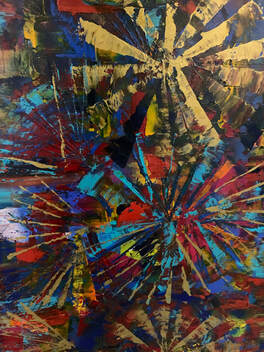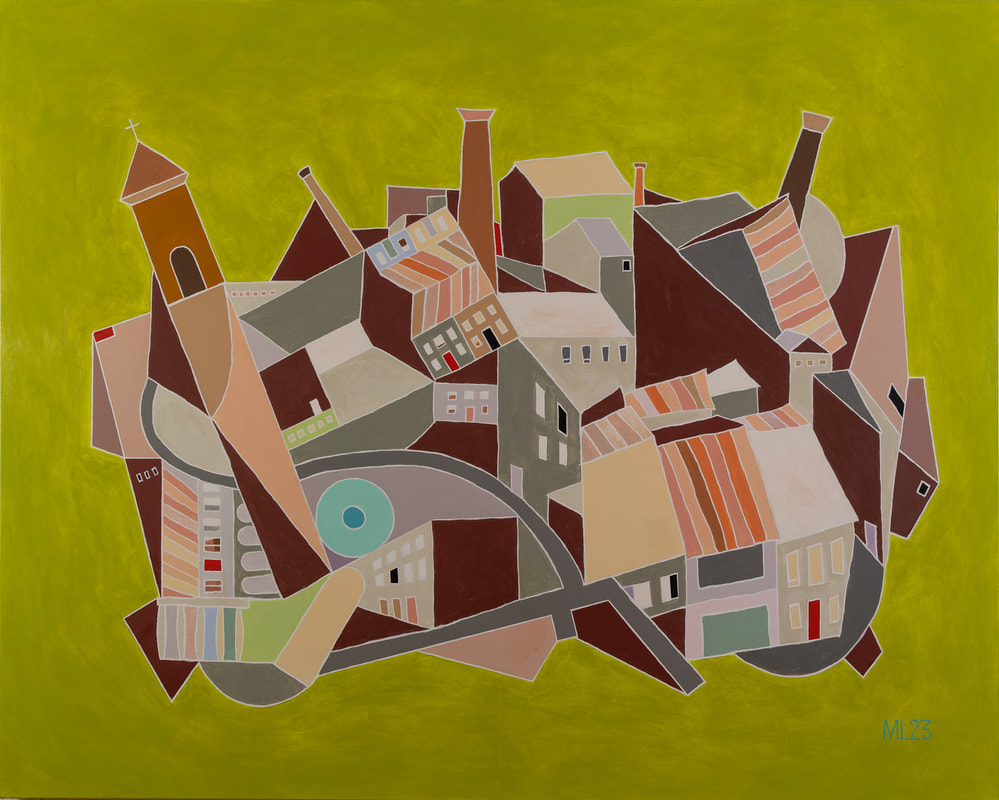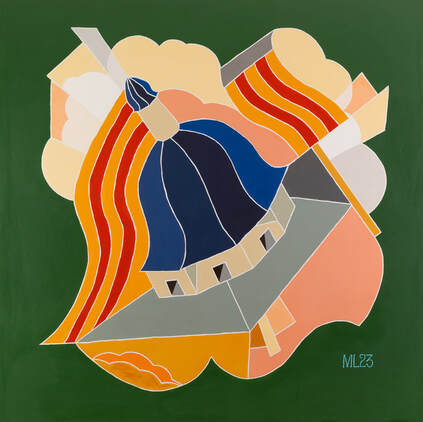 Artwork by Sandi Goodwin Artwork by Sandi Goodwin Good day, dear readers! Imagine waking up each day with the excitement and joy that accompanies New Year's Eve. The anticipation of new beginnings, the promise of resolutions, and the celebratory atmosphere—why limit these feelings to just one day a year? In this blog post, we'll explore seven pieces of advice to help you infuse the spirit of New Year's Eve into every day. Let's make each sunrise a celebration and every moment an opportunity for renewal.
0 Comments
 Folklore: The Pine barrens #1 (2023) by Elizabeth Khoury Acrylic and gauze on wood 29,7 x 21 cm Folklore: The Pine barrens #1 (2023) by Elizabeth Khoury Acrylic and gauze on wood 29,7 x 21 cm In the noise and bustle of the contemporary world, where technology evolves at a dizzying pace and cultures continuously collide, humanity's shared stories and traditions remain firmly rooted in the fertile soil of art and folklore. These timeless companions, entwined in a dance of creativity and cultural identity, continue to shape our understanding of the world, and connect us to the rich tapestry of human experience. Diverse forms and expressions in art have long been a mirror reflecting society’s soul. From ancient cave paintings to modern digital art, artists have sought to capture the essence of human experience and communicate it across time and space. Folklore weaves a narrative thread that binds communities and generations together. It is the myths, legends, and traditions that have been passed down through oral and written means, embodying the collective wisdom and imagination of a people. In the contemporary world, the intersection of art and folklore has taken on a renewed significance. As societies become more interconnected and diverse, the fusion of traditional storytelling with modern artistic mediums creates a powerful vehicle for cultural expression and understanding. Artists draw inspiration from folklore, infusing their creations with the essence of ancient tales while adapting them to resonate with contemporary audiences. Consider the resurgence of interest in mythology in popular culture, from blockbuster movies to bestselling novels. Mythical creatures and legendary heroes once confined to the pages of ancient texts now stride across the silver screen and leap off the pages of bestsellers, captivating audiences globally. This reimagining of folklore not only preserves cultural heritage but also introduces it to new generations, fostering a sense of continuity and shared identity. This blending of art and folklore also serves as a bridge between different cultures, fostering cross-cultural dialogue and understanding. In an era of globalization, where borders blur and people from diverse backgrounds coexist, the exchange of artistic expressions rooted in folklore becomes a powerful tool for building connections. Artists draw on the rich tapestry of global folklore to create works that resonate with audiences across cultural divides, celebrating our shared humanity. One notable example is the rising popularity of folk-inspired music in the contemporary music scene. Musicians from various genres incorporate traditional melodies, instruments, and storytelling techniques into their compositions, creating a sound that transcends cultural boundaries. This fusion not only preserves and revitalizes traditional musical forms but also introduces them to new audiences, creating a harmonious blend of the old and the new. The relevance of art and folklore in the contemporary world extends beyond entertainment and aesthetics. It plays a crucial role in addressing social issues and fostering a sense of belonging. Artists, drawing inspiration from the lessons embedded in folklore, create works that reflect on universal themes such as love, loss, resilience, and the human connection to nature. In doing so, they contribute to a shared cultural dialogue that transcends geographical and temporal constraints. Additionally, the incorporation of folklore into contemporary art serves as a reminder of the importance of cultural diversity and the preservation of indigenous knowledge. As globalization threatens to homogenize cultures, the celebration of folklore in art becomes a powerful assertion of cultural identity and a call to preserve the unique stories and traditions that define different communities. The symbiotic relationship between art and folklore continues to thrive in the contemporary world, shaping our understanding of ourselves and the societies we inhabit. As artists draw inspiration from ancient tales to create modern masterpieces, and as folklore finds new expression in the digital age, the timeless companions remain steadfast, weaving a narrative thread that connects us to our past and guides us into an ever-evolving future. In this dance of creativity and cultural identity, art and folklore emerge as beacons, illuminating the path to a more interconnected, understanding, and harmonious world.  Pueblo en La Huerta, which means Village in the Orchard, is a complex and abstract representation of a village or small town, composed of geometric shapes and forms that combine to create buildings, roofs, and a church tower. The color palette is muted, with earthy tones such as browns, grays, and beiges dominating the scene. There are also touches of more vibrant colors like reds and blues, adding a dynamism of life. The background is a solid green color, contrasting with the complexity of the shapes forming the village, evoking a sense of the pastoral. There is an absence of skies or natural elements like trees or plants; instead, the painting focuses solely on architectural forms. The style of the painting is clearly influenced by Cubism, Mark Lamprell uses this technique to create a sense of depth and dimensionality, as well as suggesting movement and rhythm. He also uses shading and overlapping to create volume and solidity. The painting is not realistic, but rather an abstracted version of space, where the shapes and colors are more important than the details and proportions. Mark Lamprell uses acrylic paint, a versatile medium that allows for a rich and smooth texture. It can be applied in thin or thick layers, creating different effects and expressions. It allows for the creation of a harmonious and balanced composition, where the colors and shapes complement each other and create a unified whole. The vision that Lamprell had for this painting was to capture the essence and spirit of a village in the orchard, a typical landscape of the Valencian region where he now lives. The orchard, or huerta, is a fertile and irrigated area where fruits and vegetables are grown. It is also a cultural and historical symbol of the region, as it reflects the influence of the Arab and Roman civilizations that previously occupied the land. Lamprell portrays the village as a living and dynamic entity, the shapes and colors representing people, daily activities, and traditions, which he does through his own personal and artistic vision, where he experiments with form, color, and space. The composition of the painting is based on a geometric and symmetrical arrangement, where the shapes and forms are distributed evenly and orderly. The painting is divided into two main parts: the foreground and the background. The foreground occupies most of the canvas and contains the village, which is composed of various shapes and forms that create a sense of depth and perspective. The background occupies a smaller portion of the canvas and contains the green color, which creates a sense of contrast and distance. The painting also has a focal point, which is the church tower, located in the center of the canvas. The church tower is the tallest and most prominent shape, and it draws the attention of the viewer. It also represents the traditional religious and social center of the village – its “heart” - where the people gather and celebrate. This complex and abstract representation of a Valencian village shows that shapes and colors can be more important than details and proportions when we wish to reflect the hidden realm we all seek, a place where we seek tranquility and serenity beyond the chaotic world we live in. This month sees the work of Australian writer, artist and director, Mark Lamprell, at the gallery. Songs of Valencia is a reflection of how he sees his adopted home. In this blog post we will examine how the meaning of place shifts through a stranger's gaze.
Every place holds a unique charm, a distinctive character that captivates those who set foot upon its grounds. Yet, there's an unparalleled magic in experiencing a location through the eyes of an outsider. The perspective of someone unfamiliar with the nuances and customs of a place often unveils layers of beauty, shedding light on facets that locals might overlook or take for granted. When we visit a new place, devoid of preconceptions and biases, our senses become keener, our curiosity piqued. Everything seems to stand out—the sights, sounds, smells, and even the subtle gestures and interactions of the people. A fresh perspective grants us the gift of seeing the extraordinary in the seemingly ordinary. One of the most beautiful aspects of experiencing a specific place as an outsider is the immediacy of observation. A visitor's eyes don't just glance over the landscape; they linger a little longer, absorbing the details that locals might overlook due to familiarity. Every corner holds a story waiting to be discovered—the quaint cafe tucked away in an alley, the vibrant street art adorning forgotten walls, or the way sunlight dances through the foliage of a park. An outsider's perspective often comes with a heightened sense of wonder and appreciation. The architectural marvels, cultural rituals, and local traditions that may have become routine for residents are seen with fresh enthusiasm. The vibrancy of a street market, the authenticity of a traditional dance, or the aroma of a beloved local dish—all take on an aura of novelty and excitement. Language, too, plays a pivotal role in shaping this unique viewpoint. An outsider may not be fluent in the native tongue, leading to an increased focus on non-verbal cues, gestures, and expressions. This linguistic barrier fosters a deeper connection with the essence of communication—the emotions conveyed through a smile, a nod, or a shared laugh, transcending linguistic boundaries and speaking to the universality of human connection. Moreover, the cultural differences noticed by an outsider can be a source of revelation. Customs that locals consider ordinary might appear extraordinary to visitors, sparking conversations and fostering cross-cultural understanding. These differences become bridges, connecting diverse perspectives and enriching the experience for both the observer and the observed. However, this outsider perspective is not without its challenges. Misinterpretations or misunderstandings might arise due to the lack of cultural context. Yet, these moments of confusion often lead to insightful reflections and a deeper appreciation for the complexities of a place and its people. In essence, seeing a specific place through outsider eyes is akin to discovering a hidden treasure—a journey filled with surprises, revelations, and a profound sense of appreciation. It invites us to embrace the unfamiliar, to look beyond the surface, and to find beauty in the nuances that define a place's identity. Ultimately, it's through this outsider lens that we can truly appreciate the diverse tapestry of our world, celebrating the richness found in every unique corner of our planet. |
Details
about bloomWe are a European/Lebanese run art space in Valencia, Spain. Archives
July 2024
COPYRIGHT NOTICE© Bloom Gallery. Unauthorized use and/or duplication of this material without express and written permission from this site’s author and/or owner is strictly prohibited. Small excerpts and links may be used, provided that full and clear credit is given to Bloom Gallery with appropriate and specific direction to the original content.
|
